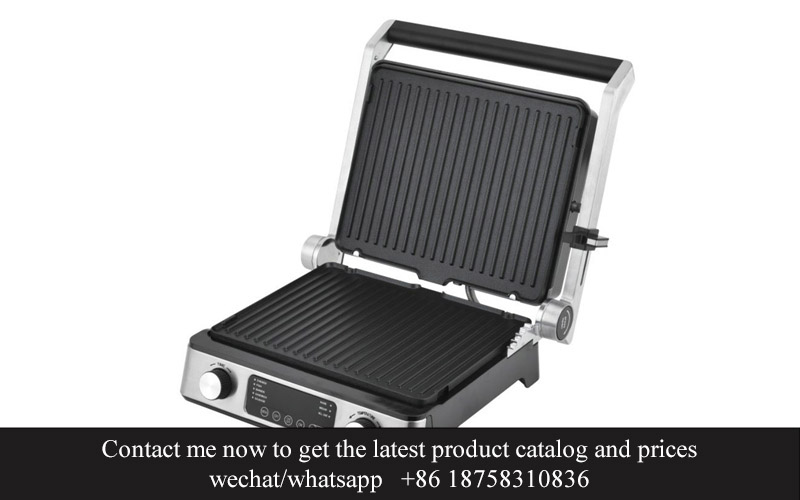Address
304 North Cardinal
St. Dorchester Center, MA 02124
Work Hours
Monday to Friday: 7AM - 7PM
Weekend: 10AM - 5PM
Address
304 North Cardinal
St. Dorchester Center, MA 02124
Work Hours
Monday to Friday: 7AM - 7PM
Weekend: 10AM - 5PM

In the ever-evolving landscape of kitchen appliances, one material stands out for its durability, hygiene, and sleek design: medical grade stainless steel. This premium material, once reserved for surgical instruments and hospital equipment, has now found its way into our kitchens, transforming the way we cook and clean. As we delve into the realm of high-quality baskets crafted from this exceptional steel, it becomes clear that the future of kitchenware is not just about functionality but also about embracing innovation and sustainability.
The medical grade stainless steel basket has emerged as a game-changer in the kitchen appliance industry, offering a blend of functionality, durability, and cleanliness that has redefined the standards for kitchenware. These baskets, crafted from the highest quality materials, are not just a tool for cooking; they are a symbol of precision and hygiene.
In the heart of modern kitchens, where efficiency meets elegance, the medical grade stainless steel basket stands out. Its sleek design and superior build quality make it a favorite among both professional chefs and home cooks alike. The basket’s ability to withstand extreme temperatures and resist corrosion places it a cut above the traditional metal or plastic alternatives.
The journey of the medical grade stainless steel basket begins with the raw material—a high-grade stainless steel that meets stringent medical standards. This material is not only known for its resilience but also for its hygienic properties, which are crucial in food preparation environments. The process of manufacturing these baskets involves a series of meticulous steps, each designed to ensure that the end product is not just durable, but also safe for use.
The design of the medical grade stainless steel basket is both simple and sophisticated. Its walls are crafted with precision, ensuring that food is evenly cooked and drained efficiently. The handles are ergonomically designed for a comfortable grip, making it easy to maneuver in and out of pots and pans. The smooth interior of the basket prevents food particles from sticking, making cleaning a breeze.
One of the standout features of the medical grade stainless steel basket is its versatility. Whether it’s for steaming vegetables, poaching fish, or deep-frying, this basket can handle a variety of cooking methods. Its ability to maintain its shape and integrity even when exposed to high heat or extreme cold makes it a reliable companion in the kitchen.
In the realm of kitchen appliances, innovation is key, and the medical grade stainless steel basket is no exception. Manufacturers are continuously pushing the boundaries of design and functionality. From baskets with built-in temperature gauges to those with non-slip bases, the possibilities are endless. These advancements not only enhance the cooking experience but also add a touch of modern sophistication to any kitchen.
The market for medical grade stainless steel baskets is witnessing a surge in demand, driven by health-conscious consumers and the rise of gourmet cooking. Supermarkets and specialty stores are increasingly featuring these baskets in their kitchenware sections, recognizing the value they bring to the consumer. The premium price point is justified by the quality and longevity of the product, which often outlasts its cheaper counterparts.
Behind the scenes, the manufacturing process is a testament to precision engineering. The raw steel is cut, shaped, and polished to the highest standards, ensuring that each basket is a work of art in its own right. The attention to detail is unparalleled, with every aspect of the basket’s design and construction carefully considered to meet the needs of the consumer.
In terms of maintenance, the medical grade stainless steel basket is a dream. It requires minimal care, with a quick rinse and occasional wash with mild detergent being all that’s needed to keep it sparkling clean. This not only saves time but also ensures that the basket remains hygienic, a crucial factor in food safety.
The medical grade stainless steel basket has also become a favorite among health professionals. Its ability to maintain a consistent temperature and prevent cross-contamination makes it an ideal tool for preparing meals that are both safe and nutritious. The basket’s non-reactive nature ensures that the flavor and nutritional value of the food are preserved, which is a significant advantage for those following specific dietary guidelines.
As the kitchen appliance industry continues to evolve, the medical grade stainless steel basket is poised to play a pivotal role. Its combination of advanced technology, innovative design, and health-conscious appeal positions it as a leader in the market. The basket’s ability to enhance the cooking experience and contribute to a safer, more efficient kitchen environment is a testament to the power of innovation in everyday life.
In conclusion, the medical grade stainless steel basket is more than just a kitchen utensil; it’s a symbol of the future of culinary preparation. Its rise in popularity is a clear indication that consumers are seeking products that offer not just convenience, but also health and peace of mind. As the industry continues to embrace new technologies and materials, the medical grade stainless steel basket is likely to remain a staple in modern kitchens for years to come.

The journey of kitchen appliances has been a testament to human ingenuity and technological advancements. From the rudimentary tools of our ancestors to the sleek, smart devices of today, the evolution of kitchen appliances reflects our evolving needs and aspirations.
Once, the kitchen was a realm of manual labor, with cooking tasks performed using primitive tools like pots, pans, and primitive ovens. Fire was the primary source of heat, and the process of cooking was often time-consuming and unpredictable. Over time, however, the landscape of the kitchen began to change.
The advent of the gas stove in the late 19th century marked a significant shift. It brought efficiency and consistency to cooking, replacing the open flame with a controlled, adjustable heat source. This innovation not only reduced cooking times but also made it possible for families to enjoy a wider variety of dishes.
As the 20th century unfolded, kitchen appliances became more specialized and widespread. The refrigerator, introduced in the early 20th century, revolutionized food preservation, allowing families to store perishable goods for longer periods. The blender, the electric mixer, and the food processor followed suit, simplifying food preparation and reducing the physical labor required in the kitchen.
The 1950s and 1960s saw a surge in the development of electric appliances, with the microwave oven emerging as a game-changer. It transformed the way we heated and cooked food, making it possible to reheat leftovers or cook meals with minimal effort. The rise of the countertop appliance, such as the toaster, coffee maker, and juicer, further expanded the convenience of kitchen life.
In the late 20th century, technology began to intersect with the kitchen, leading to the rise of smart appliances. These devices, often equipped with programmable settings and connectivity, allowed users to control their kitchen gadgets remotely and even receive notifications about maintenance or energy consumption.
The 21st century has brought about a new era of kitchen appliances that are not only smart but also sustainable. Energy-efficient models have become the norm, and manufacturers are increasingly focusing on reducing the environmental impact of their products. The integration of AI and machine learning into kitchen appliances has led to innovations such as self-cleaning ovens and intelligent refrigerators that can predict and suggest recipes based on stored ingredients.
Throughout this evolution, kitchen appliances have grown more powerful, efficient, and user-friendly. They have also become more adaptable to individual preferences and dietary needs, with a variety of features catering to different lifestyles and culinary habits. From the simple tasks of boiling water and toasting bread to the complex processes of baking, roasting, and grilling, kitchen appliances have become indispensable companions in our daily lives.
The evolution of kitchen appliances is not just a story of convenience; it’s a reflection of societal changes. As we continue to progress, the kitchen of the future promises to be even more integrated into our daily routines, with appliances that not only simplify our lives but also enhance our overall experience in the heart of the home.

Medical grade stainless steel has emerged as a game-changer in the kitchen appliance industry, offering a myriad of benefits that have redefined the standards for durability, hygiene, and performance. Let’s delve into the reasons behind the rising popularity of this superior material.
The first and foremost advantage of medical grade stainless steel lies in its unparalleled strength and resilience. This type of stainless steel is designed to withstand the rigors of constant use, ensuring that kitchen appliances made with it can last for decades without losing their structural integrity. Its robustness is a testament to its high carbon content, which contributes to its ability to maintain a sharp edge and resist bending, even under heavy loads.
Hygiene is another critical aspect that medical grade stainless steel addresses exceptionally well. In the kitchen, where cleanliness is paramount, the non-porous nature of this material is invaluable. Unlike other metals that can harbor bacteria and germs, medical grade stainless steel’s smooth surface prevents the growth of microorganisms. This feature is particularly important in environments where food safety is a top priority, such as in commercial kitchens or food processing facilities.
Moreover, the corrosion resistance of medical grade stainless steel is nothing short of remarkable. Unlike regular stainless steel, which can rust and tarnish over time, medical grade variants are engineered to withstand exposure to harsh chemicals and acidic environments. This durability means that kitchen appliances made with medical grade stainless steel are less likely to require frequent maintenance or replacements, ultimately saving both time and money for users.
Aesthetics also play a significant role in the appeal of medical grade stainless steel. Its sleek, modern appearance adds a touch of sophistication to any kitchen space. The material’s reflective properties enhance the brightness of the environment, making it a favorite among designers and homeowners who seek a clean, professional look. The timeless appeal of medical grade stainless steel ensures that kitchen appliances remain in vogue, even as design trends evolve.
One of the standout features of medical grade stainless steel is its ability to resist heat. This is crucial in kitchen appliances where high temperatures are a norm, such as oven racks or grill grates. The material can withstand extreme heat without deforming or losing its surface finish, making it a reliable choice for components that come into direct contact with heat sources.
In terms of sustainability, medical grade stainless steel is a green choice. It is fully recyclable, and its lifespan means fewer appliances end up in landfills. This eco-friendly aspect aligns with the growing consumer demand for environmentally conscious products, which is a driving force behind the adoption of medical grade stainless steel in kitchen appliances.
Another advantage worth mentioning is the ease of cleaning. Medical grade stainless steel’s smooth surface is not only resistant to bacteria but also to stains. A simple wipe with a damp cloth or a mild detergent is often all it takes to maintain its pristine condition. This ease of maintenance not only saves time but also reduces the need for harsh cleaning agents, which can be harmful to the environment.
When it comes to performance, medical grade stainless steel outshines other materials in its ability to distribute heat evenly. This characteristic is particularly beneficial in cookware, where temperature control is essential for achieving the perfect meal. The material’s heat conductivity ensures that heat is distributed throughout the appliance, preventing hot spots and improving cooking efficiency.
Lastly, the versatility of medical grade stainless steel cannot be overstated. It can be easily shaped and formed into a wide array of designs, from sleek minimalist styles to more intricate and ornate patterns. This adaptability allows manufacturers to create appliances that cater to a diverse range of aesthetic preferences and functional requirements.
In conclusion, the benefits of medical grade stainless steel in kitchen appliances are multifaceted. Its strength, hygiene, corrosion resistance, aesthetic appeal, heat resistance, sustainability, ease of cleaning, and versatility make it an ideal choice for those who demand excellence in their kitchenware. As the kitchen appliance industry continues to evolve, it’s clear that medical grade stainless steel will remain a cornerstone material, shaping the future of modern kitchens.

In the world of kitchen appliances, innovation is the key driver behind the evolution of everyday tools. The stainless steel basket industry, in particular, has seen a surge in creative designs that not only enhance functionality but also elevate the aesthetic appeal of kitchenware. Here’s a closer look at some of the innovative designs shaping the stainless steel basket industry:
The integration of smart technology has been a game-changer for stainless steel baskets. Baskets now come with built-in sensors that can monitor cooking temperatures and times, ensuring that your dishes are perfectly cooked every time. This technology isn’t just for the professional chef; it’s making its way into home kitchens, offering convenience and precision.
Designers are exploring the use of modular baskets, which can be easily dismantled and reconfigured to fit different pots and pans. This not only saves space but also allows for a more adaptable kitchen setup. The modular concept has become a hit, especially among those with limited storage space or who frequently host dinner parties where various cooking vessels are needed.
One of the most significant trends in the industry is the focus on eco-friendly materials and sustainable production methods. Stainless steel baskets are now being designed with a focus on reducing waste and energy consumption during the manufacturing process. From recycled stainless steel to water-efficient production lines, these eco-conscious designs are resonating with environmentally aware consumers.
The aesthetic appeal of stainless steel baskets has expanded beyond the typical industrial look. Modern designs now feature sleek, minimalist lines that complement contemporary kitchen aesthetics. Some brands are even introducing colored finishes, blending the practicality of stainless steel with the vibrancy of color, offering a personalized touch to kitchen decor.
Functional integration is another area where innovation is flourishing. Baskets are now being designed with integrated draining systems, which eliminate the need for additional colanders. This not only streamlines the cooking process but also reduces the clutter on kitchen counters. The combination of a basket and a colander in one piece is a practical solution for busy cooks.
The ergonomic design of stainless steel baskets has also seen improvements. Handles are being made more comfortable and easier to grip, reducing the strain on the cook’s hands and wrists. Some baskets even come with non-slip bases and secure locking mechanisms to prevent movement during cooking, ensuring a safe and stable cooking environment.
The use of advanced coatings and finishes has opened up new possibilities for stainless steel baskets. These coatings not only protect the steel from corrosion and stains but also improve heat resistance. This means that baskets can withstand higher temperatures, making them suitable for a wider range of cooking techniques.
In the realm of customization, some manufacturers are offering personalized stainless steel baskets. Customers can choose from a variety of sizes, shapes, and even add their names or initials to the baskets. This level of personalization has become popular among collectors and those who appreciate unique kitchenware.
The integration of health and safety features is also a key aspect of the industry’s innovation. Baskets are being designed with rounded edges to prevent injuries, and some even come with antimicrobial properties to reduce the risk of foodborne illnesses. These features are particularly appealing to health-conscious consumers who prioritize cleanliness in their kitchens.
Lastly, the concept of multipurpose baskets has gained traction. These baskets can be used for a variety of tasks, from steaming vegetables to washing fruits, making them a versatile addition to any kitchen. Their versatility and adaptability have made them a staple in many modern kitchens.
In summary, the stainless steel basket industry is witnessing a renaissance in design, with a focus on functionality, sustainability, and personalization. These innovative designs are not only making cooking easier and more enjoyable but are also adding a touch of modern elegance to the heart of the home.

In the ever-evolving landscape of kitchen appliances, market trends are shaping the future of how we cook, clean, and manage our culinary spaces. Here’s a glimpse into the trends that are poised to redefine the industry:
Smart IntegrationThe integration of smart technology into kitchen appliances is not just a trend; it’s a revolution. From refrigerators that can order groceries to ovens that can be controlled via smartphone, the future kitchen is becoming more connected than ever. These smart appliances not only enhance convenience but also offer users insights into their cooking habits and energy consumption.
Sustainability and Eco-Friendly PracticesConsumers are increasingly aware of the environmental impact of their purchases. As a result, there’s a growing demand for appliances that are energy-efficient and sustainable. This includes not just the appliances themselves but also the materials used in their construction. Companies that embrace eco-friendly practices and use recycled materials are likely to gain a competitive edge in the market.
Health and Safety FeaturesWith health concerns at the forefront, kitchen appliances are being designed with safety and health benefits in mind. Features like touchless controls to prevent the spread of germs, non-toxic materials, and intuitive interfaces that are easy for the elderly or those with disabilities to use are becoming standard. The industry is also seeing a rise in appliances that can monitor and adjust cooking temperatures to prevent overcooking and reduce the risk of fires.
Personalization and CustomizationThe days of one-size-fits-all kitchen appliances are fading. Modern consumers are looking for products that can be tailored to their specific needs and preferences. This trend is driving the development of modular appliances that can be customized with different attachments and features. From adjustable oven racks to variable-speed blenders, the ability to personalize kitchen tools is becoming a key selling point.
Energy Efficiency and EfficiencyEnergy efficiency is a cornerstone of the future kitchen appliance market. As energy costs rise, consumers are seeking appliances that consume less power without compromising performance. Innovations like induction cooktops, which use less energy than traditional electric or gas burners, and LED lighting in appliances are becoming more prevalent. The industry is also focusing on improving the efficiency of refrigeration and ventilation systems.
Design and AestheticsThe kitchen has always been a space for showcasing style, and the appliance industry is responding with sleek, modern designs. Appliances that blend seamlessly into the kitchen’s aesthetic, whether it’s through color matching or concealed handles, are becoming more popular. The emphasis on aesthetics extends to the materials used, with stainless steel remaining a favorite for its clean look and durability.
Health Monitoring and Cooking AssistanceAppliances that can monitor and adjust cooking processes based on health guidelines are on the rise. For example, ovens that can automatically adjust cooking times and temperatures to ensure that food is cooked to a safe internal temperature are becoming more common. Additionally, smart cookers that can provide nutritional information and suggest healthier cooking options are becoming a norm.
Smart Home IntegrationThe kitchen is no longer just a room in the house; it’s a hub of the smart home. Appliances that can be integrated with other smart devices, such as thermostats, security systems, and voice assistants, are becoming more sophisticated. This integration allows for greater control and automation, making the kitchen a more efficient and user-friendly space.
In conclusion, the future of kitchen appliances is marked by a blend of technology, sustainability, personalization, and health-conscious design. As these trends continue to evolve, consumers can expect a kitchen that is not only a place of culinary creation but also a testament to the latest advancements in home technology.

In the realm of kitchen appliances, the adoption of medical grade stainless steel baskets has led to remarkable success stories. These case studies highlight the benefits and impact of these high-quality baskets in various settings.
In a renowned restaurant chain, the switch to medical grade stainless steel baskets for their oven trays has significantly improved the cooking process. The baskets’ durability and non-reactive nature ensure that food retains its flavor and texture, leading to increased customer satisfaction. The baskets have also proven to be easy to clean and maintain, reducing downtime in the busy kitchen environment.
A high-end catering service has experienced a notable boost in efficiency with the integration of medical grade stainless steel baskets in their commercial ovens. The baskets’ even heat distribution and ability to withstand extreme temperatures have allowed for precise cooking control, resulting in perfectly cooked dishes every time. The baskets’ sleek design also adds a touch of sophistication to their presentation, enhancing the overall dining experience.
In a home kitchen setting, a professional chef has embraced medical grade stainless steel baskets for their homemade pastries. The baskets’ fine mesh design allows for even baking and helps achieve a perfect rise, ensuring that every pastry turns out as delicious as it does in a commercial bakery. The baskets have become an essential tool in the chef’s arsenal, streamlining the baking process and elevating the quality of their creations.
A wellness center has found medical grade stainless steel baskets to be a game-changer in their infrared saunas. The baskets provide a stable and even surface for the clients to place their body on, ensuring a consistent and comfortable experience. The baskets’ non-porous surface also prevents any bacteria or mold from forming, maintaining a hygienic environment. The baskets have become a staple in their facility, enhancing the overall customer experience.
In the world of gourmet coffee, a coffee shop has incorporated medical grade stainless steel baskets into their espresso machines. The baskets’ precision fit ensures that the coffee grounds are evenly packed, leading to a smoother and more flavorful shot. The baskets’ ability to withstand high temperatures without deforming has also extended the life of their espresso machines, reducing maintenance costs and downtime.
An outdoor grill manufacturer has integrated medical grade stainless steel baskets into their line of products. These baskets offer a versatile cooking surface that can be used for a variety of foods, from vegetables to seafood. The baskets’ durable construction allows them to withstand the harsh outdoor elements, ensuring long-lasting performance. The inclusion of these baskets has been a hit with customers, who appreciate the ease of use and convenience they offer.
A culinary school has adopted medical grade stainless steel baskets for their professional kitchens. The baskets’ quality and precision are invaluable for teaching students the art of cooking. The baskets’ ability to handle various types of food and cooking methods makes them an essential tool in the classroom. The baskets have become a staple in the school’s kitchenware inventory, fostering a culture of excellence in culinary education.
These case studies showcase the versatility and reliability of medical grade stainless steel baskets across different industries. From commercial kitchens to home chefs, these baskets have proven to be a valuable asset, enhancing efficiency, quality, and overall satisfaction. As the demand for high-quality kitchenware continues to grow, medical grade stainless steel baskets are poised to become a staple in the industry, driving innovation and excellence in kitchen appliance design.

In the world of culinary arts, the opinions of both home chefs and professionals carry significant weight. Here’s a glimpse into what they have to say about the integration of medical grade stainless steel baskets in kitchen appliances.
The home chefs appreciate the durability and hygiene that these baskets bring to their cooking routines. They often comment on how the non-porous surface of the stainless steel prevents food from sticking and makes cleaning a breeze. One home chef, Sarah, shared, “I love how my stainless steel basket holds its shape, even after hours of simmering. It’s a game-changer for my stews and soups.”
Professionals, on the other hand, are drawn to the baskets’ ability to maintain their integrity over time. Chef Michael, who runs a high-end restaurant, notes, “The medical grade stainless steel baskets we use are a testament to quality. They don’t warp or rust, which is crucial for maintaining the presentation and safety of our dishes.”
Home chefs also value the versatility of these baskets. “I use my stainless steel basket for everything from steaming vegetables to poaching eggs,” says Emily, a frequent baker. “It’s a must-have for anyone who loves to experiment with different cooking methods.”
Professional chefs often discuss the practicality of medical grade stainless steel baskets. “The handles are ergonomically designed, making it easy to maneuver the baskets in and out of pots and pans,” explains Chef Laura. “This feature alone has saved us countless hours in the kitchen.”
Another point of praise from both home and professional chefs is the baskets’ compatibility with various appliances. “I can use my stainless steel basket in the oven, on the stove, and even in the microwave,” says Tom, a hobbyist chef. “It’s incredibly convenient and versatile.”
Safety is a major concern for both groups, and medical grade stainless steel baskets address this with their resistance to corrosion and heat. “I feel confident using these baskets for my seafood dishes,” says Chef Alex. “The stainless steel ensures that there’s no risk of metal leaching into the food.”
Hygiene is another key factor highlighted by both home chefs and professionals. “The smooth surface of the baskets makes it easy to sanitize, which is essential in a kitchen,” notes Sarah. “I can rest assured that my stainless steel basket is clean and safe for my family’s meals.”
Chefs also appreciate the aesthetic appeal of medical grade stainless steel baskets. “The sleek design of these baskets adds a touch of sophistication to my kitchen,” says Emily. “They look great on display and are a testament to the quality of my cooking equipment.”
In conclusion, the feedback from home chefs and professionals alike is overwhelmingly positive. The medical grade stainless steel baskets have become a staple in many kitchens, offering durability, versatility, and peace of mind. From the ease of cleaning to the ability to withstand the rigors of professional cooking, these baskets have proven to be a valuable addition to any kitchen.

In the quest to produce high-quality stainless steel baskets, manufacturers face a myriad of challenges that require innovative solutions. From the selection of raw materials to the intricate details of manufacturing processes, each step is crucial in ensuring the end product meets the stringent standards required for both commercial and domestic use.
The demand for medical grade stainless steel baskets has surged, driven by their durability and hygienic properties. However, the path to achieving such high standards is not without its hurdles. One of the primary challenges is the consistency of the stainless steel material itself.
Maintaining the purity of stainless steel is a delicate balance. Impurities can compromise the basket’s structural integrity and resistance to corrosion. Manufacturers must source their raw materials from reputable suppliers who can guarantee the highest quality. This often involves rigorous testing and certification processes to ensure that the steel meets the required specifications.
Once the raw material is secured, the manufacturing process becomes a dance of precision and craftsmanship. The bending, cutting, and welding of stainless steel require skilled laborers who understand the material’s properties and behavior. A slight misstep can lead to a basket that is either too weak or too brittle.
One solution to this challenge is the adoption of advanced machinery that can handle the precision required for these tasks. CNC (Computer Numerical Control) machines have revolutionized the manufacturing industry, allowing for consistent and repeatable production processes. These machines can be programmed to make intricate cuts and bends with pinpoint accuracy, reducing the margin for human error.
Another challenge lies in the post-manufacturing process. The baskets must be thoroughly cleaned and polished to ensure they meet the hygiene standards set by the medical industry. Traditional cleaning methods may not be sufficient, as they can leave behind microscopic particles that could contaminate the basket’s contents.
To address this, some manufacturers have turned to state-of-the-art cleaning technologies. Ultrasonic cleaning uses high-frequency sound waves to create tiny bubbles that implode on the surface of the baskets, effectively removing any dirt or bacteria. This method is not only effective but also gentle on the material, preserving the basket’s integrity.
Yet another challenge is the need for customization. Many customers require baskets tailored to specific dimensions or with unique features. This requires a high degree of flexibility in the manufacturing process, which can be both costly and time-consuming.
To overcome this, some companies have developed modular manufacturing systems. These systems allow for the assembly of baskets using interchangeable components, making it easier to create custom solutions without starting from scratch. This not only reduces production time but also minimizes waste.
In the world of high-quality basket manufacturing, quality control is paramount. Every basket must undergo a series of inspections to ensure it meets the required standards. This can be a labor-intensive process, as each basket is checked for defects, durability, and compliance with specifications.
To streamline this process, manufacturers have implemented automated inspection systems. These systems use advanced imaging technology to detect even the smallest imperfections that the human eye might miss. By integrating these systems into the production line, manufacturers can maintain a high level of quality control without significantly slowing down production.
Lastly, the challenge of sustainability cannot be overlooked. As the world becomes more environmentally conscious, manufacturers must find ways to reduce their carbon footprint. This involves not only using sustainable materials but also optimizing production processes to minimize waste and energy consumption.
One solution is the use of renewable energy sources in manufacturing facilities. Solar panels and wind turbines can provide a significant portion of the energy needed, reducing reliance on fossil fuels. Additionally, implementing recycling programs for scrap materials and using eco-friendly cleaning agents are ways to contribute to a greener manufacturing process.
In conclusion, the challenges faced in manufacturing high-quality stainless steel baskets are multifaceted, ranging from material purity to post-manufacturing processes and quality control. However, with innovative solutions and a commitment to excellence, manufacturers are able to overcome these hurdles and deliver products that meet the highest standards of quality and reliability.

The environmental impact of manufacturing processes has become a critical concern across various industries, and the kitchen appliances sector is no exception. From sourcing materials to disposal, every stage of the production lifecycle can have significant ecological implications. Here’s an exploration of the challenges and the emerging solutions in the manufacturing of high-quality stainless steel baskets, focusing on sustainable practices.
Materials Sourcing: The demand for stainless steel baskets necessitates the extraction of raw materials, primarily steel, which is often sourced from iron ore mines. The mining process can lead to habitat destruction and water pollution. To mitigate these issues, manufacturers are increasingly looking to recycled stainless steel. By sourcing recycled materials, companies can significantly reduce their carbon footprint and the strain on natural resources.
Energy Efficiency: The production of stainless steel baskets involves melting and forging processes that require substantial amounts of energy. Energy consumption not only contributes to greenhouse gas emissions but also drives up production costs. Innovations in energy-efficient technologies, such as using induction heating instead of traditional furnaces, have begun to transform the industry. These technologies not only save energy but also reduce waste and pollution.
Waste Reduction: Waste management is a significant challenge in the manufacturing sector. The production of stainless steel baskets generates a considerable amount of scrap metal and other by-products. Manufacturers are adopting strategies to minimize waste, such as optimizing production processes to reduce material loss and implementing recycling programs for scraps. These efforts help in diverting waste from landfills and reducing the overall environmental impact.
Water Conservation: Water usage in manufacturing can be extensive, particularly in the cleaning and cooling stages of the production process. Some stainless steel basket factories have invested in closed-loop systems that recycle water, significantly reducing consumption. Additionally, the use of alternative cooling methods, such as air cooling instead of water-based systems, has become more prevalent, further conserving this precious resource.
Employee Health and Safety: The health and safety of workers are not only a moral imperative but also crucial for the sustainability of a manufacturing operation. In the stainless steel basket industry, exposure to hazardous materials can occur, and thus, maintaining a safe working environment is vital. Implementing strict safety protocols and providing personal protective equipment (PPE) to employees are essential steps in ensuring both the workers’ well-being and the sustainability of the operation.
Supply Chain Transparency: Ensuring that the entire supply chain is sustainable is a challenge but a necessary one. From the source of raw materials to the final product, every link must be transparent. Companies are working to establish partnerships with suppliers who adhere to environmental and ethical standards. This transparency not only supports sustainable practices but also builds trust with consumers who are increasingly conscious of where their products come from.
Community Engagement: The impact of manufacturing activities extends beyond the factory walls. Responsible manufacturers are engaging with local communities to address any negative effects their operations might have. By investing in local infrastructure, supporting community development projects, and providing employment opportunities, manufacturers can help ensure that their activities contribute positively to the environment and society.
Certifications and Standards: The pursuit of sustainability has led to the development of various certifications and standards, such as ISO 14001 for environmental management systems. Adhering to these standards can help manufacturers demonstrate their commitment to sustainability. Achieving such certifications often requires a significant transformation within the organization, driving continuous improvement in environmental performance.
Innovation and Research: Investing in research and development is crucial for developing new materials and technologies that are more sustainable. Innovations like the use of biodegradable coatings or the development of stainless steel alloys that require less energy to produce are examples of how the industry is pushing the boundaries of sustainability.
In conclusion, the challenges faced by the stainless steel basket industry in terms of environmental impact are substantial, but so are the solutions being implemented. By focusing on sustainable practices across the production lifecycle, manufacturers can not only minimize their ecological footprint but also enhance their reputation and competitiveness in a market that values environmental responsibility.

In the realm of kitchenware, the integration of medical grade stainless steel has become a beacon of innovation and reliability. This material, once reserved for the most demanding applications in healthcare, has now found its way into the heart of kitchen appliances. The shift is not just about materials; it’s a testament to the evolving needs and expectations of consumers who seek not just efficiency but also longevity and safety in their kitchen tools.
The demand for high-quality, durable kitchenware has grown exponentially, and with it, the demand for materials that can withstand the rigors of daily use without compromising on performance or aesthetic appeal. Medical grade stainless steel has stepped into this gap, offering a blend of properties that make it an ideal choice for the modern kitchen.
One of the key benefits of medical grade stainless steel is its exceptional resistance to corrosion. Unlike traditional stainless steel, which can tarnish and degrade over time, medical grade steel maintains its integrity, even when exposed to acidic or alkaline substances commonly found in kitchen environments. This longevity ensures that kitchenware made from this material will stand the test of time, providing a lasting investment for consumers.
Moreover, the hygienic qualities of medical grade stainless steel are unparalleled. It is non-porous, which means it doesn’t harbor bacteria or food particles, making it a perfect choice for food preparation and cooking. This characteristic is particularly important in professional kitchens, where health codes are strict and the potential for cross-contamination is high.
Innovative designs in the stainless steel basket industry have leveraged these properties to create a range of products that cater to both the professional chef and the home cook. From fine mesh baskets for delicate cooking methods to larger, sturdy baskets for washing and draining, the versatility of medical grade stainless steel is evident in the variety of products available.
The market trends indicate a clear preference for sustainable and health-conscious products. Consumers are becoming more aware of the environmental impact of their purchases and are actively seeking out materials that are not only beneficial to their health but also to the planet. Medical grade stainless steel aligns with these values, as it is recyclable and has a lower carbon footprint compared to other metals used in kitchenware.
Case studies of successful implementations of medical grade stainless steel baskets show a remarkable transformation in the kitchenware market. For instance, a renowned kitchenware brand replaced their standard steel baskets with medical grade stainless steel, resulting in a significant reduction in customer complaints about rust and corrosion. The positive feedback was overwhelming, with many customers noting the basket’s durability and ease of cleaning.
Home chefs and professionals alike have shared their perspectives on the benefits of these baskets. “The non-reactive nature of the steel means my food doesn’t taste metallic,” says a professional chef. “And the fact that it’s so easy to clean is a game-changer in my busy kitchen.” Home cooks echo these sentiments, appreciating the baskets’ ability to withstand harsh cleaning agents without losing their shine.
Manufacturing high-quality baskets is not without its challenges. Ensuring the correct thickness and grade of stainless steel is crucial for maintaining the integrity of the product. Additionally, the precision required for welding and assembling these baskets must be meticulous to avoid any weak points. Solutions to these challenges include investing in state-of-the-art equipment and training skilled artisans who understand the nuances of working with medical grade stainless steel.
The environmental impact of the industry is also a critical concern. To address this, manufacturers are adopting sustainable practices such as reducing energy consumption, optimizing recycling processes, and sourcing raw materials responsibly. These efforts are not just ethical but also resonate with environmentally conscious consumers who are increasingly making purchasing decisions based on sustainability.
In conclusion, the rise of medical grade stainless steel in kitchenware is a testament to the industry’s ability to adapt to changing consumer needs. It’s a material that combines health, durability, and sustainability, offering a glimpse into the future of kitchenware. As the industry continues to innovate and refine its practices, it’s clear that medical grade stainless steel will remain a cornerstone of the modern kitchen, providing a reliable and hygienic solution for all culinary endeavors.